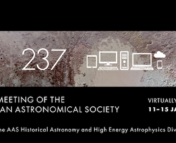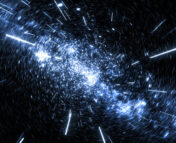In this series of posts, we sit down with a few of the keynote speakers of the 242nd AAS meeting to learn more about them and their research. You can see a full schedule of their talks here, and read our other interviews here!

Our universe is rapidly expanding. This discovery, key to all of modern cosmology, is arguably one of the most significant developments in physics over the past century. And yet, if you were to ask a group of cosmologists what the universe’s current rate of expansion is, you likely couldn’t get a straight answer. It’s either close to 67.7 km/s/mpc (kilometers per second per megaparsec) or 73 km/s/kpc, depending on the set of measurements you look at, and no one knows which one will ultimately turn out to be correct. How can this be?
The story and potential future of this so-called Hubble tension is the focus of this year’s Fred Kavli Plenary Lecture, given by Duke University professor Daniel Scolnic. Through his work measuring the expansion rate of the universe with Type Ia supernovae over the past decade, Prof. Scolnic has been at the forefront of numerous studies which have solidified the existence of this discrepancy —a process which has not always been easy.
“On a personal level it’s been stressful”, Prof. Scolnic told me when I asked what it felt like to be a part of such a significant development in cosmology. “I think I didn’t appreciate when we were starting to do some of these things just how much attention this would get.”
Measuring the Expansion of Space with Exploding Stars
As an undergraduate at MIT, Prof. Scolnic was initially interested in particle physics. Motivated by the search for bigger and bigger questions, however, he quickly found himself at the opposite end of the distance scale studying cosmology and the expansion of the universe. “I was always attracted to the bigger stuff,” he told me. “When I got the chance to, late in my undergrad time, I’d write some code doing some cosmology thing and I’d have a bug, and the bug would make the universe go from like 13 billion years old to like 50 billion years old… And I was like, how cool is this that I have one little typo and suddenly the whole age of the universe has changed!” Ever since making the switch, first by doing a summer of research with cosmologist Adam Riess, Prof. Scolnic’s work has centered around the use of Type Ia supernovae in cosmology. Type Ia supernovae are particularly useful for measuring the expansion rate of the universe because they all form the same way, emitting roughly the same amount of light no matter where they are in the universe. Thus, by measuring how bright each one appears to us on Earth, we can get a good estimate of their distance. This consistency is essential for cosmologists, who want to accurately map the universe and its behavior on the largest possible distance scales. Cosmologists like Prof. Scolnic find them so valuable that they’ve made careers out of measuring them: “There’s not another standard candle that’s just so luminous and so standardizable,” he said. (Astrophysical objects with consistent intrinsic luminosities are known as “standard candles”).
Throughout the 2000s, measurements of the expansion rate of the universe, also known as the “Hubble constant” or H0, varied approximately between 60 and 80 km/s/mpc, with uncertainties large enough to make it plausible that everyone’s measurements were compatible. Beginning in the early 2010s, however, two distinct approaches began returning incompatible results. Those using standard candles to estimate distances to farther and farther galaxies (the so-called “distance ladder” method) were steadily approaching a value close to 73 km/s/mpc, while those using precision measurements of the cosmic microwave background (CMB) were beginning to hone in on a lower value. In 2013, an analysis of the European Space Agency’s Planck satellite measurements of the CMB returned a value of 67.3 km/s/mpc. Around this time, Prof. Scolnic completed his PhD at Johns Hopkins University and began working in the Supernova H0 for the Equation of State (SH0ES) collaboration. “What everyone was telling me as we were working on these next measurements was that we were gonna kinda follow planck and get a lower value.” Professor Scolnic explained. But in the ensuing years, the problem only got worse. The 2016 SH0ES collaboration, along with subsequent analyses of their data, returned a value of H0 around 73 km/s/mpc, now with even smaller uncertainties. The small uncertainties on both sets of measurements now put the results in 3-sigma tension with each other, roughly meaning there was only about a 0.1% chance that the difference could be explained by random statistical fluctuations. The modern Hubble tension was born. “We were not expecting it… we weren’t looking for the Hubble tension in any way, it just kinda fell in our lap in some ways,” Scolnic said
“What explains this… we have no idea”
For some in the field, the emergence of a discrepancy like this as an opportunity to rework our standard model of cosmology. Employing one of his go-to analogies, Prof. Scolnic explains, “the way to think about this Hubble tension is with a growth chart… we have this picture of the universe as a baby [maps of the CMB], we have this picture of a universe today, and we need a model to connect them. The model is our standard model of cosmology, and basically if you do this you don’t predict what my team sees today.” But despite numerous attempts at explaining the discrepancies with new cosmological models, none of them have convinced the broader community so far. “The biggest reason why people push back a lot at the idea that this Hubble tension is real is that there isn’t a great theoretical explanation for it”, Prof. Scolnic explained. “When the discovery of the accelerating universe came… there was this cosmological constant theory ready to kinda tie things together,” he said, “It’s not like that this time around… there’s these things that don’t work but nothing is ready to kinda tie pieces together in a theoretical way.”
Where some see opportunity for new cosmologies, others have expressed various degrees of skepticism. Prof. Scolnic noted that the history of the Hubble constant is fraught with these sorts of discrepancies. In the 1990s, there was a heated debate within the cosmology community over whether H0 was 50 km/s/kpc or closer to 100 km/s/kpc, which came to an end with the advent of more precise measurements in the early 2000s. “What I hear, especially from more senior astronomers, is ‘ugh, I remember when it was 50 vs 100, I’m not going to get excited over 67 vs 73’… The legacy of that definitely still haunts the field.” Regardless, something must explain the discrepancy, so the hunt for a good explanation continues. “[The astrophysics] community is extremely good at finding mistakes… I would often wake up each morning and get an email from someone in some different part of the world saying ‘I looked at your data and I think this is wrong’,” Prof. Scolnic went on to note the personal toll this sort of critical attention can take: “Our community is also not good at keeping things to be not so personal… Part of it is just how we talk about papers, [other physicists] will be like ‘well Scolnic et. al. did this’ and I’ll be like, oh that’s my name, you’re insulting me!” he said jokingly. But in ensuing analyses, such as one released in 2022 by a combination of the Pantheon+ and SH0ES teams (of which Prof. Scolnic is a leading member), a significant effort was put into addressing the concerns of other researchers, and the problem didn’t go away. In fact, the Hubble tension has only grown over the past few years, thanks in part to the work of Prof. Scolnic and his collaborators. Now the two sets of measurements are 5-sigma apart, roughly translating to there being only a one-in-a-million chance of the discrepancy being due to random fluctuations in the data. Prof. Scolnic expressed that he felt confident after these recent analyses that there really is a discrepancy here, but that ultimately “what explains this… we have no idea.”
Finding Joy in what We Don’t Know
While uncovering new mysteries in science can cause tension, Prof. Scolnic believes this process is part of what’s really exciting about being a researcher. Thinking back to being a student, he emphasized the importance of stepping back and remembering that doing science isn’t about getting good grades or memorizing equations: “I got focused on getting really good grades and all these other things and I think I forgot the coolness and the joy of learning itself… I lost sight that there’s all these things we don’t know about the universe… I think when you’re in college it’s easy to be like ‘okay read these chapters, here’s Maxwell’s equations, learn this,’ and that sense of discovery you’re not getting with the same immediacy as when you’re doing research.” When it comes to exploring these unknowns, Prof. Scolnic also believes strongly in the virtues of collaboration. “I think for me the toughest times have been when I’ve felt lonely in my research. Not just that it’s hard, but that you’re doing something and there’s kinda no one to talk to, to do it with you, to bounce things off of. Even when [I make] mistakes… with other people it’s been much more joyous than doing something well by myself.”
If you’d like to hear more about the past, present, and future of the Hubble tension and beyond, tune into Prof. Scolnic’s Plenary Lecture at 8:10 AM (MDT) on Monday, June 5 at #AAS242!
Edited by: Sumeet Kulkarni
Featured Image Credit: AAS




